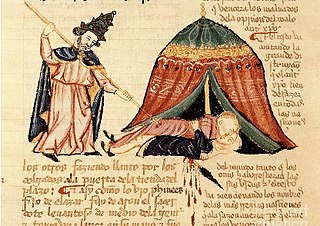The Wandering in the Desert

Having fixed the Exodus in the year 763 BCE and the Fall of Jerusalem in 343 BCE—tentatively, at least—we are left with 420 years to accommodate the intervening history of the ancient Israelites. According to the Bible, as interpreted by James Ussher, quite a lot happened between those two epochal events:
| Event | Duration (years) |
|---|---|
| Wandering in the Desert | 40 |
| Conquest of Canaan | 38 |
| Period of the Judges | 318 |
| United Monarchy | 120 |
| Divided Monarchy to the Fall of Israel | 254 |
| Kingdom of Judah to the Fall of Jerusalem | 133 |
| Total | 903 |
Source: James Ussher, Annals of the World
In Ussher’s Annals of the World, this period of Jewish history spans 903 years. He placed the Exodus in 1491 BCE and the Fall of Jerusalem in 588 BCE. If the Short Chronology is even remotely accurate, much of that history has to go, or, at the very least, be compressed into a much tighter timeframe. Among the leading lights of the Short Chronology, two of the brightest were Charles Ginenthal and Lynn E Rose, both of whom are now deceased. In reconstructing the history of the ancient Israelites, I have often taken my lead from them, but I have also differed from them on a number of points. Ginenthal’s solution to the problem of squeezing 903 years of history into a period of about 450 years was to simply jettison a lot of it:

Having moved the Hebrew Exodus/Hyksos expulsion into the 8th century B.C. ... the masses of people leaving Egypt would not find the Sinai Desert as it is today but rather a relatively savannah-like environment dotted with trees, bushes, and grasses. What flocks they brought or commandeered from the Egyptians before they began this journey would thus have found reasonably ample grazing possible. Nevertheless, the biblical claim of the people staying there for 40 years is simply not provable ...
The Israelites were not returning as foreigners to their homeland ... Therefore, upon their return they were integrated into that society to enlarge it and enrich it. What is being suggested here is that there was no conquest by Joshua nor a period of Judges. As is well known, no-one has found archaeological evidence of the conquest ...
As is obvious to the reader, the short chronology of Heinsohn and Sweeney fully explains another archaeological/historical problem, enigma, contradiction that is inexplicable with the established chronology. Because the Israelites were Canaanites in Egypt, when they returned home there was no need for conquest, no need for cultural or linguistic or other change. The archaeological evidence fits the short chronology–hand in glove.
The implications of this fact are as follows: (1) Since there was no conquest of Palestine, the material on Joshua is only a biblical story meant to explain, by those who had no evidence of him, the period following the Exodus. In other words, the Book of Joshua is a creation by the writers of the Bible to show how the Israelites took the land of Israel and, therefore, that period never existed. (2) Since Joshua did not exist because there was no need to destroy the Canaanites, the integration of the Egyptian Canaanites/Palestinians into their homelands was rapid. This also means the Book of Judges is superfluous as well and a creation of these same writers. (Ginenthal 2010:541-544)
Ginenthal and Rose place the accession of Saul as first King of Israel around 750 BCE, leaving only thirteen years for the period between the Exodus and the Monarchy. The wandering in the desert, the conquest of Canaan, and the period of the Judges are simply relegated to the pages of fiction.
But I am not convinced.

The Wandering in the Desert
For forty years, Moses and the Jews wandered in the desert. Every schoolchild in the West knows that. But did it actually happen? If not, then it must have been fabricated. But why would anyone make up such a story? What significant purpose does it serve in the history of the Jews? If, as Ginenthal believed, the Israelites simply left Egypt and settled peacefully in Canaan, then why is that story not recounted in the Bible? Why invent four centuries of history?
My instinct tells me that if the Wandering in the Desert were a pure fabrication, it would never have become such an iconic part of Jewish history.
Another prominent Short Chronologist, Emmet J Sweeney, who was referenced by Ginenthal in the extract above, sets the Exodus around 850 BCE, about a century earlier than the chronology I am following. Sweeney, however, has amassed a body of documentary evidence that lends credence to the historicity of the Wandering in the Desert and the Period of the Judges:

The extraordinary episode of the parting sea is mirrored in a tale from the time of king Sneferu, and more particularly in the El Arish inscription, where the god Horus is credited with expelling Asiatics eastwards, through the Red Sea, after a pharaoh had pursued them into the “place of the whirlpool” (Velikovsky 49-53). There is other evidence however which suggests that the story of the Exodus, and the epic events associated with it, became widely known throughout the Near East. Most particularly, there appear to be very clear references to the event in Greek tradition. Thus for example the flight of the Danaids from Aegyptus (Egypt) seems to refer to the flight of the Israelite tribe of Dan, during the escape from bondage. This is confirmed by the story’s close link to the legend of Cadmus, the hero credited with introducing the Phoenician alphabet to Greece. In this tradition Agenor, the twin brother of Belus (father of Danaus and Aegyptus), was said to have left Egypt to settle in the land of Canaan. Shortly thereafter, Agenor’s daughter Europa was abducted by Zeus, whereupon he ordered his sons, who are named as Cadmus, Thasus, Cilix, Phoenix, and Phineus, to set out in search of her (Apollodorus 3:1:1).

The occurrence of the name Phineus in particular provides probably the most direct and unequivocal link with the Exodus. There seems little doubt that the Greek Phineus is one and the same as Phinehas, the grandson of Moses’ brother Aaron, who slays the Israelite Zimri along with his Midianite bride in their tent (Numbers 25:6-15). In the Greek legend Phineus (or Phineas) attacks Perseus along with his bride Andromeda, daughter of the king of Joppa (Jaffa), at their wedding feast, but is slain by the Gorgon’s head, which Perseus exposes (Ovid 5:1-230). Again, in another tradition the Greeks told how Phineus, who had been plagued by harpies, was rescued by two of the Argonauts, Calais and Zetes, who pursued the harpies through the air (Apollonius Rhodius 2:178 ff). This accords with a Jewish tradition about Phinehas which has the flying swordsman Zaliah pursue Balaam through the air, on the orders of Phinehas (Ginzberg 410-411).
The story of the Danaids, as well as that of Agenor and Phineus, must have arrived in Greece through the same channels as the Phoenician alphabet. After their entry into Canaan the Twelve Tribes were allocated separate territories. Dan’s portion was in the very north of the country—regions now comprising eastern Lebanon (Judges 18:7-28). It is known that they became closely associated with the Phoenician kingdoms of the region. Some of the Phoenician traders and settlers who brought the alphabet to Greece must have been from the tribe of Dan. (Sweeney 118-120)
The persistence of the story of Phinehas or Phineus in the traditions of both the Jews and the Greeks suggests to me that it has an ancient and factual basis. If the story of the Wandering in the Desert was made up in Persian times by Jewish scholars, the story of Phineus could hardly have found its way into the Catalogue of Women, a fragmentary epic poem, which was once attributed to Hesiod but is currently dated to about 540 BCE (Hesiod 171, 177, 179).

Archaeology
Archaeologists have generally rejected the historicity of the Wandering in the Desert because they have failed to find any evidence for it. Asked by journalists about the Exodus and the forty years of wandering the desert in search of the Promised Land, Egypt’s chief archaeologist Zahi Hawass replied:
“Really, it’s a myth ... This is my career as an archaeologist. I should tell them the truth. If the people are upset, that is not my problem ... Sometimes as archaeologists we have to say that never happened because there is no historical evidence ” (Slackman 3 April 2007)
Hawass was showcasing the recent discovery and excavation of an ancient Egyptian fortress in northern Sinai:
In Egypt today, visitors to Mount Sinai are sometimes shown a bush by tour guides and told it is the actual bush that burned before Moses. But archaeologists who have worked here have never turned up evidence to support the account in the Bible, and there is only one archaeological find that even suggests the Jews were ever in Egypt ... The same diggers found evidence of a military fort with four rectangular towers, now considered the oldest fort on the Horus military road. But nothing was showing up that might help prove the Old Testament story of Moses and the Israelites fleeing Egypt, or wandering in the desert. Hawass said he was not surprised, given the lack of archaeological evidence to date. (Slackman 3 April 2007)
In defence of the Wandering in the Desert, there are three possible responses we can make to the archaeologists:
- The number of Israelites given in the Bible is a gross exaggeration.
- The forty years of the Biblical account is a gross exaggeration.
- The traditional route is not the actual route taken by the Israelites.
To be continued ...
References
- Apollodorus, The Library, Volume 1, with an English Translation by Sir James George Frazer, William Heinemann, London (1921)
- Apollonius Rhodius, The Argonautica, with an English Translation by R C Seaton, William Heinemann, London (1919)
- Charles Ginenthal, Egypt and Palestine, Pillars of the Past, Volume 3, Forest Hills, New York (2010)
- Louis Ginzberg, The Legends of the Jews, Volume 3, Translated from the German by Paul Radin, The Jewish Publication Society of America, Philadelphia (1911)
- Hesiod, Hesiod, The Homeric Hymns, and Homerica, with an English Translation by Hugh G Evelyn-White, Harvard University Press, Cambridge MA (1943)
- Ovid, Metamorphoses, with an English Translation by Frank Justus Miller, Volume 1, Harvard University Press, Cambridge MA (1951)
- Michael Slackman, The New York Times, 3 April 2007, A G Sulzberger, New York (2007)
- Emmet John Sweeney, The Pyramid Age, Ages in Alignment, Volume 2, Algora Publishing, New York (2007)
- James Ussher, Larry and Marion Pierce (editors), The Annals of the World, Revised and Updated from the 1658 English Translation, Master Books, Green Forest, AR (2003)
Image Credits
- The Sinai Desert: Wikimedia Commons, © The Paleobear, Creative Commons License
- The Jews in the Desert: Tintoretto (artist), © Web Gallery of Art, Fair Use
- Charles Ginenthal: © Dwardu Cardona, Fair Use
- Emmet J Sweeney: © Society for Interdisciplinary Studies (SIS), Fair Use
- The Zeal of Phinehas: Wikimedia Commons, Alba Bible (1430), Public Domain
- Perseus Turning Phineus and His Followers to Stone: Wikimedia Commons, Luca Giordano (artist), Public Domain

nice & informative post..
thanks for sharing with us..
I appreciate it..👍👍👍👍
thanks a lot for giving such informative history..
we wants more dear @harlotscurse
Surely many important moments were lost in summarizing biblical facts in that way.
everyone should know about their religious history..
thanks for sharing your informative post dear @harlotscurse
It is shocking that documented evidence leads us to doubt the existence of characters and events narrated in the Bible.
yaah..another great history!
great story.thnx a lot for share
nice blog.keep it up
informative history.thnx a lot @harlotscurse
excellent history👏👌👌✌